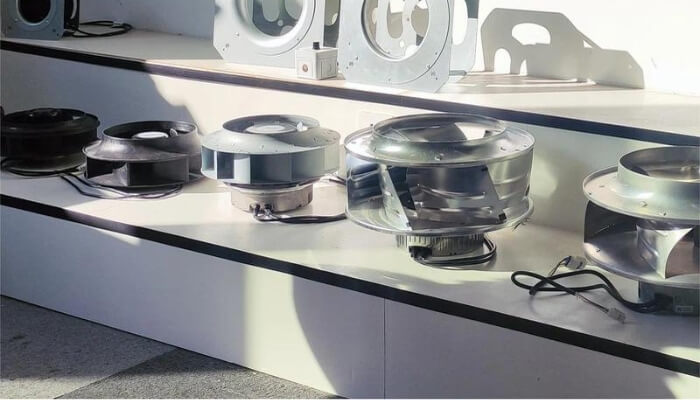Because they provide effective airflow and ventilation, centrifugal fans are essential in numerous industrial and commercial applications. In any case, the centrifugal fans noise commotion produced by these fans can present critical difficulties, affecting both laborer solace and, by and large, functional effectiveness. Understanding and carrying out compelling noise-commotion control strategies is vital to relieve these issues.
This article investigates three vital strategies for diminishing radiating fan commotion: Acoustic Enclosures and Barriers, Vibration Isolation and Damping, and Aerodynamic Optimization methods. By tending to the main drivers of noise commotion, these methodologies can assist with establishing a calmer and more useful surrounding climate.

Table of Contents
ToggleUnderstanding Centrifugal Fans Noise
You can use centrifugal fans in a variety of industries due to their effectiveness in moving air and other gases. Notwithstanding, regardless of their benefits, these fans can create critical noise commotion, which can be a central issue in both modern and business settings. The commotion created by outward fans can originate from a few sources, including streamlined factors, mechanical parts, and the collaboration of airflow with encompassing designs.
The development of air principally produces streamlined clamor through the fan’s sharp blades or edges and the disturbance made as the air leaves the fan. This clamor is affected by the design and speed of the fan cutting edges, as well as the wind current examples they produce. Mechanical commotion, then again, emerges from the vibration and grating of the fan’s moving parts, like heading and engine parts. Furthermore, the primary commotion can happen when the fan’s activity sends vibrations to local surfaces and designs, enhancing the general clamor level.
Sources of Noise in Centrifugal Fans
Noise in centrifugal fans can be ascribed to a few essential sources, each adding to the general sound profile of the fan. Understanding these sources is pivotal for executing compelling noise-commotion control measures. The principal wellsprings of clamor in divergent fans include:
Mechanical Noise
Bearing Noise: Bearing supports the alternating shaft of the fan, and their rubbing and defects can produce clamor. Ineffectively greased up or broken down directions are normal wellsprings of mechanical clamor.
Motor Noise: The fan’s electric engine can deliver commotion because of electromagnetic powers, engine windings, and cooling fans inside the engine.
Imbalance and Misalignment: An imbalanced fan impeller or skewed engine can cause inordinate vibration, prompting commotion. This can occur because of assembling deformities, mileage, or inappropriate establishment.
Aerodynamic Noise
Turbulence: As fan sharp edges pass by a proper point, they make occasional tension variances, resulting in commotion. This noise’s frequency is correlated with the number of blades and fan speed.
Flow Separation: The development of air through the fan and around its sharp edges creates choppiness, causing sporadic gaseous tension variances that produce commotion. Disturbance is more articulated at higher fan speeds and with less effective blade designs.
When wind currents over the edges, it can sometimes separate from the surface, making vortices and extra commotion. This peculiarity is impacted by the point of the edges and the speed of the air.
Structural & Electrical Noise
Vibration Transmission: Vibrations created by the fan can be sent to the fan packaging, ventilation work, and encompassing designs, enhancing the commotion. These vibrations can emerge from both streamlined and mechanical sources.
Resonance: Primary parts of the fan or its mounting can resound at specific frequencies, expanding commotion levels. The natural frequency of the components matching the fan’s operation frequency can cause this resonance.
Basic Principles of Centrifugal Fans Noise Measurement and Reduction
Method 1 – Acoustic Enclosures and Barriers
- Design and Function of Acoustic Enclosures
Acoustic enclosures encase centrifugal fans, decreasing noise commotion outflows by retaining and containing sound. Some key points include:
Materials:
High-thickness, sound-retaining materials like mineral wool, foam, or composite panels are regularly used to build enclosures.
Development:
Powerful enclosures highlight impenetrable seals, thick walls, and vibration-hosing mounts to prevent commotion leakage & spillage. The inside surfaces are frequently fixed with sound-retaining materials to lessen commotion levels.
Ventilation:
Appropriate ventilation should be kept up to prevent overheating while at the same time limiting noise escape. This can be accomplished by utilizing silencers, mufflers, and baffles to permit wind current while hosing clamor. The essential capability of acoustic enclosures is to trap and assimilate the commotion created by the fan, keeping it from spreading to the surrounding climate.
Effectiveness of Acoustic Barriers
- Heavier and thicker materials give better sound weakening. Concrete, metal, and acoustically designed panels are some common materials.
- Boundaries ought to be tall and long enough to hinder the immediate way of sound waves from the fan to the collector.
- Situating obstructions near the commotion source as conceivable augments their adequacy by limiting the distance sound waves can travel unrestricted.
Method 2 – Vibration Isolation and Damping
Vibrations from the rotation and complex components of radial fans can create critical noise commotion. These vibrations can likewise be sent to encompassing designs, causing auxiliary commotion sources through reverberation and amplification.
Techniques for Vibration Isolation
Elastic Mounts:
Elastic or spring mounts detach the fan from its mounting surface, decreasing the transmission of vibrations. These mounts ingest and disperse vibrational energy, keeping it from being sent to the supporting designs.
Adaptable Connectors:
Consolidating adaptable joints or connectors in ventilation work and piping keeps vibrations from being communicated through rigid connections. These connectors can assimilate and hose vibrations, lessening commotion engendering.
Balanced Parts:
Guaranteeing that fan impellers and other turning parts are appropriately adjusted limits vibrational clamor. Irregular characteristics can cause inordinate vibrations, prompting expanded commotion levels and possible mechanical disappointments.
Damping Materials:
Damping materials to fan lodgings and other underlying parts can retain and disseminate vibrational energy, decreasing noise clamor. These materials convert vibrational energy into heat, which is then scattered.
Isolation Bases:
When mounting fans, isolation bases or platforms can further reduce vibration transmission. These bases frequently consolidate damping materials and adaptable mounts to disengage the fan from the floor or backing structure.
Method 3 – Aerodynamic Optimization
Aerodynamic noise clamor in centrifugal fans emerges from the association of wind current with the fan cutting edges and encompassing designs. This commotion can be high, particularly at high fan speeds or with wasteful designs. Key elements adding to streamlined commotion include:
Turbulence:
Noise is caused by pressure fluctuations caused by irregular and chaotic airflows. High choppiness levels are commonly tracked around inadequately planned fan-cutting edges and sharp edges.
Flow Separation:
When air passes over a surface, like a fan blade, it may occasionally detach, resulting in noise-making vortices. Stream division is affected by the point and state of the edges.
Blade Passing Frequency:
Clamor is produced as fan edges occasionally pass by a decent point, making dull tension variances. This commotion part is straightforwardly connected with the speed of the fan and the quantity of edges.
Techniques for Aerodynamic Optimize Centrifugal Fans Noise
Blade Design:
Airflow can be improved and turbulence reduced by using blades with sophisticated shapes and optimized angles. Airfoil-molded edges, for instance, are intended to limit drag and commotion by making smoother wind stream ways.
Speed Control:
Executing VSDs permits the fan to work at ideal velocities for explicit circumstances, decreasing clamor. Running the fan at lower speeds during diminished requests can bring down commotion levels.
Flow Straighteners and Guides:
Introducing flow straighteners at the fan bay or outlet helps adjust the wind current, decreasing turbulence and commotion. These gadgets guarantee that the air enters and leaves the fan in a more organized way. Adding guide vanes at vital focuses inside the fan framework can coordinate wind stream all the more effectively, diminishing clamor brought about by fierce or flighty air developments.
Duct Design:
Designing pipes with smooth and slow changes decreases choppiness and related commotion. Sudden conduit size or course shifts can make tempestuous wind currents and expand commotion levels. Any obstructions in the ventilation work can cause wind stream disturbances, prompting clamor.
Regular Maintenance:
You need to clean and inspect the fan blades and ducts to ensure no clogs or damages could affect airflow. Indeed, even little aggregations of residue or trash can make disturbance and increment commotion. Guaranteeing that all moving parts are greased up and appropriately changed limits mechanical grinding and vibrations, adding to generally speaking, sound decrease.
Conclusion
Controlling noise from centrifugal fans is essential for maintaining operational efficiency and improving workplace comfort. The three vital techniques — working on a streamlined plan, utilizing commotion retaining materials, and executing vibration separation — give thorough answers for diminishing clamor at its source. By incorporating these procedures, enterprises can reduce commotion levels, prompting a more wonderful work space and expanded efficiency. Proactive commotion among the executives benefits representatives and adds to consistency with clamor guidelines, guaranteeing long-haul functional achievement.
